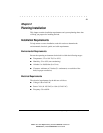
. . . . . . . . . . . . . . . . . . . . . . . . . . . . . .
1-12
Overview
Writer:
Chris Seiter
Project:
Compaq Netelligent 2724/2824 Dual-Speed Hub User Guide
Comments:
299440-001
File Name:
2824_1.DOC
Last Saved On:
6/27/97 4:02 PM
Segmentation
A segment is a single collision domain where all network traffic within that
domain contends for the same bandwidth. The Netelligent 2724/2824 hub has a
10 Mb/s segment and a 100 Mb/s segment that are connected via an internal
two-port (10 Mb/s / 100 Mb/s) switch. The process of segmentation lets you
isolate the 10 Mb/s segment from the 100 Mb/s segment, which prevents packet
forwarding between the two segments and isolates the hub’s 10 Mb/s segment
from the common 100 Mb/s backplane. This can improve the bandwidth in your
network by reducing the number of nodes that contend for the same segment
thereby reducing collisions. For information about isolating the
10 Mb/s segments, see “Internal 10/100 Switch Disable DIP Switch.”
You can also isolate the hub’s 100 Mb/s segment from the common 100 Mb/s
backplane in a stack. To do so, view the Stack Configuration screen of the
VT100 interface and set the Backplane Status field to “Isolated” (see “Appendix
B – Using the VT100 Interface” for more information). Or, set the
n2feBkplnStatus MIB variable using a MIB browser or SNMP management
application such as Compaq Netelligent Management Software.
All 2824/2724 ports have access to the management agent regardless of
connection speed as long as they have access to the stack’s common 100 Mb/s
backplane. When any hub’s internal 10/100 switch is disabled, its 10 Mb/s
connections lose their access to the agent. When a manageable hub (2724) is
isolated from the common 100 Mb/s backplane, all ports lose their access to the
management agent. 100 Mb/s connections on the managing (2824) hub always
have access to the agent, regardless of the hub’s configuration.


















